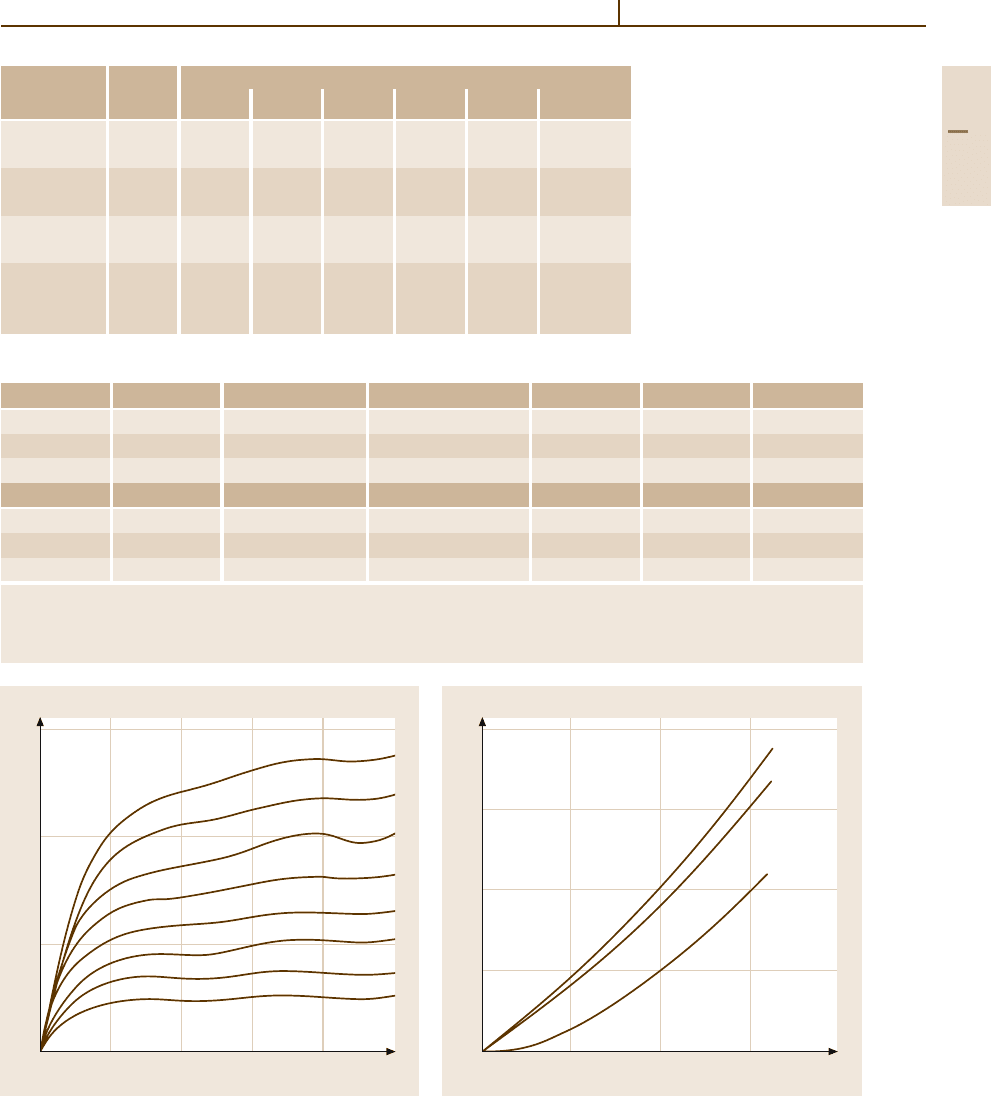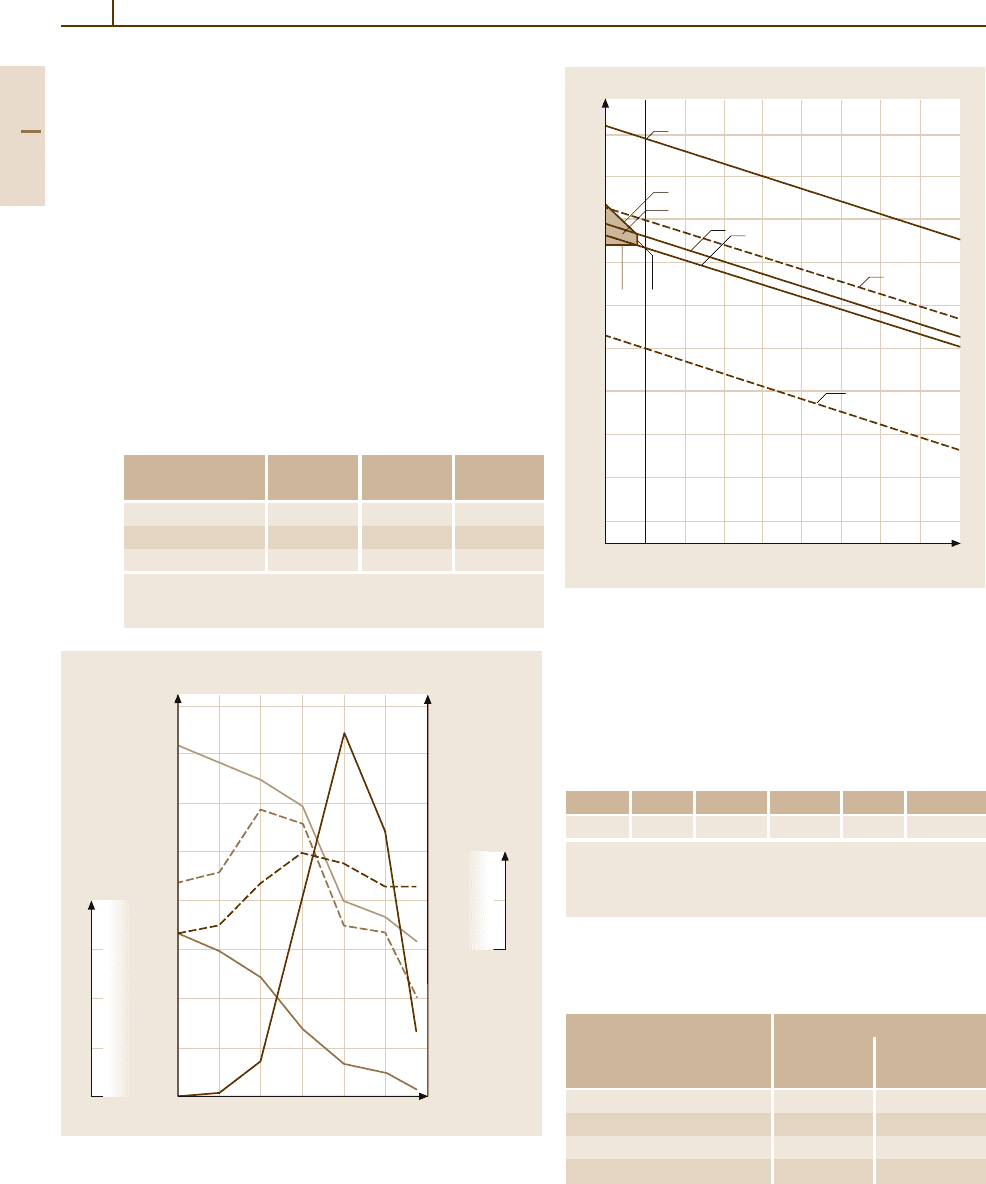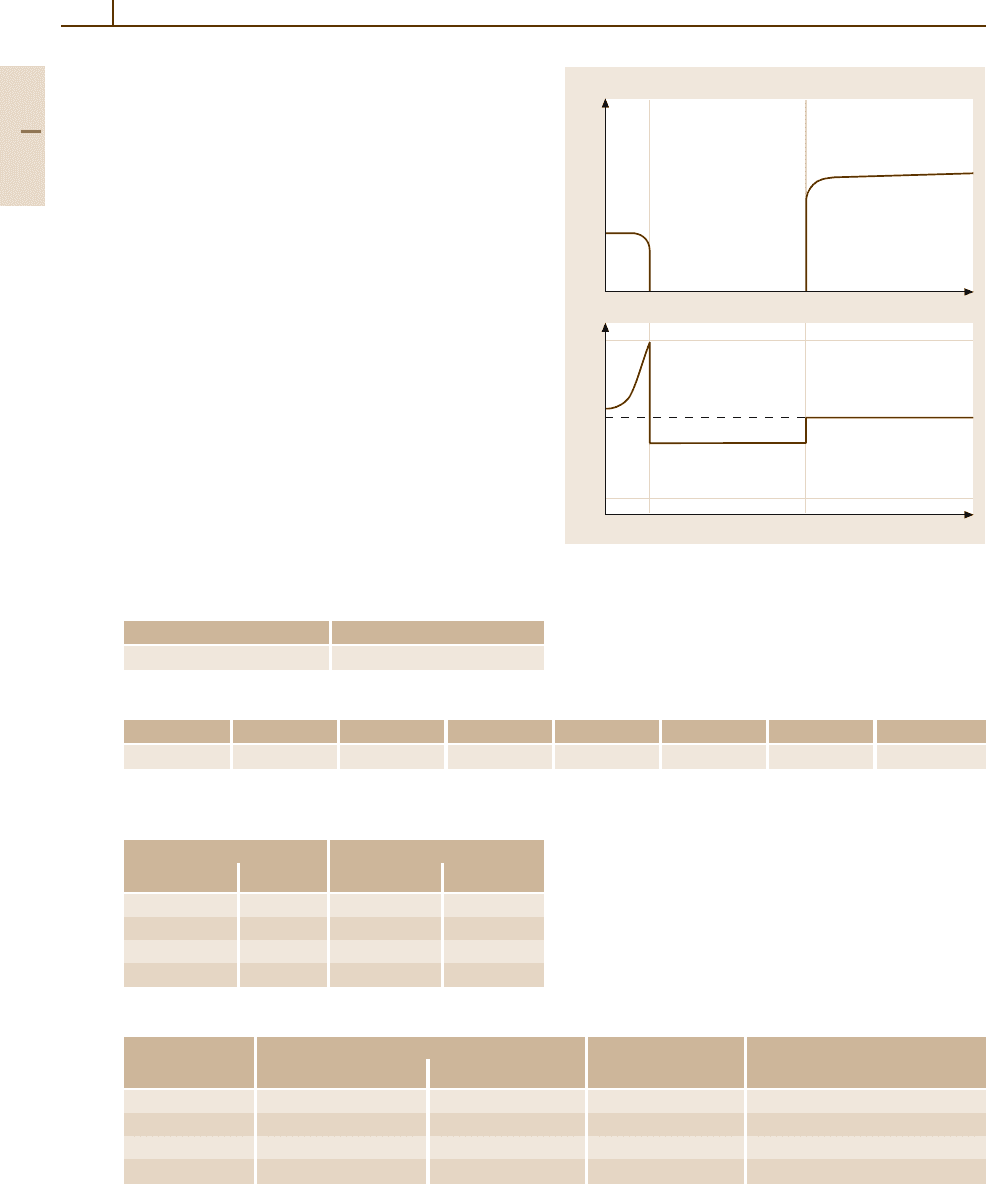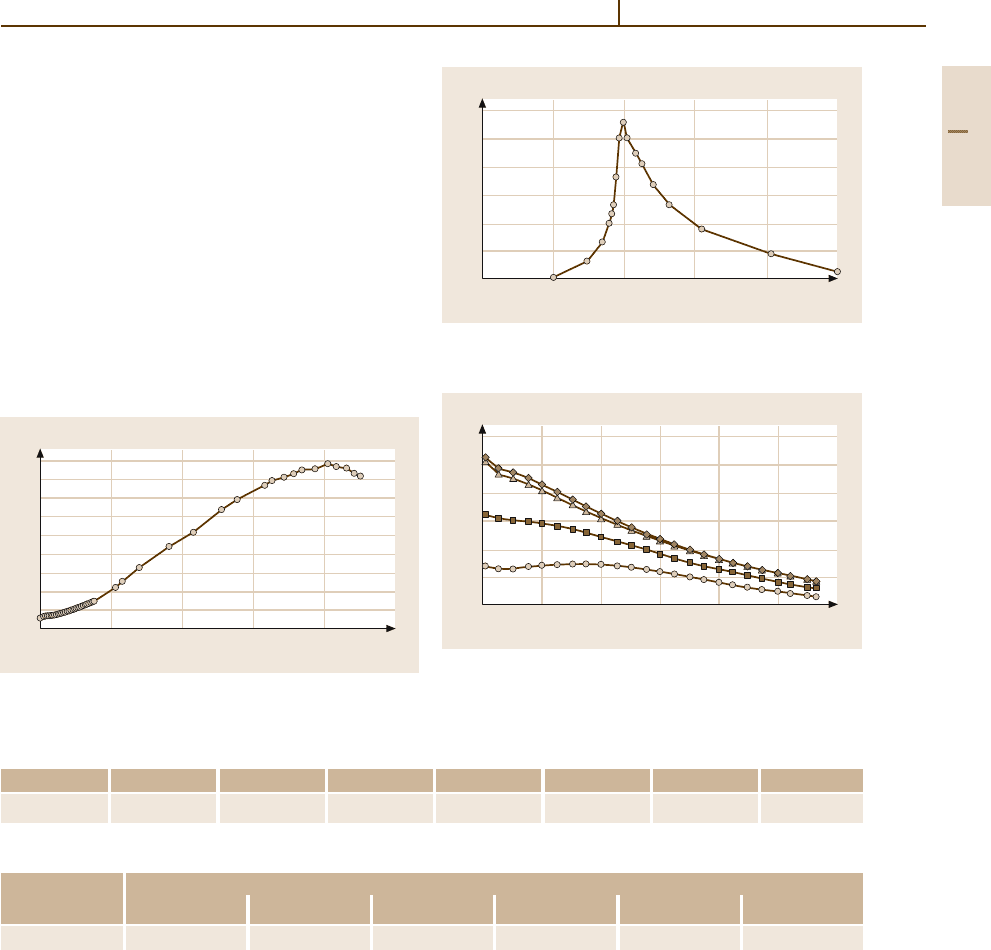Martienssen W., Warlimont H. (Eds.). Handbook of Condensed Matter and Materials Data
Подождите немного. Документ загружается.


382 Part 3 Classes of Materials
Table 3.1-227 Specific electrical resistivity (µΩ cm) of Pt at temperature (K) [1.217, p. 157]
T (K) 10 50 120 273 673 1273 1673
ρ (µΩ cm) 0.0029 0.719 3.56
5
9.83 24.57 37.45 53.35
0.4
0.3
0.2
0.1
0
1
Tungsten (%)
800
600
400
200
0
Pt 2 3 4
Coefficient (nΩ m/K) Resistivity (nΩ m)
Electrical
resistivity
20 °C
(68 °F)
Temperature coefficient
of resistivity
0 to 100 °C
(32 to 212 °F)
Fig. 3.1-293 Electrical resistivity and temperature coeffi-
cient of resistivity (TCR) of Pt
−
W alloys as a function of
composition [1.228, p. 697]
Thermoelectric Properties.
Selected values of thermal
electromotive force of Pt and Pt alloys are given in
Tables 3.1-206, 3.1-207, 3.1-228 – 3.1-231 [1.216, 217,
222], and Fig. 3.1-295 [1.216]. Thermocouples that are
Pt
−
Rh-based are especially suited for high temperatures
(see Fig. 3.1-296).
Table 3.1-228 Pt
−
Rh thermocouples according IEC 5845
(see Fig. 3.1-296) [1.217, p. 472]
Class Alloy Maximum applicable
temperature (
◦
C)
Type R: PtRh(87/13)–Pt 1500–1600
Type S: PtRh(90/10)–Pt 1500–1600
Type B: PtRh(70/30)–Pt 1750–1800
Table 3.1-229 Absolute thermoelectric power of Pt [1.222, p. 1009]
Temperature (K) 300 400 500 600 700 800 900 1000 1100 1200
Thermoelectric power (µV/K) −5.05 −7.66 −9.69 −11.33 −12.87 −14.38 −15.97 −17.58 −19.03 −20.56
20
10
0
95 85
Pt (wt %)
30
20
10
0
30
20
10
0
90Pt
Thermal electromotive force E
A, Pt
(mV)
t
2
= 1200 °C
t
1
= 0 °C
Re
Ta
W
Os
Ir
Rh
Pd
Ru
Nb
Mo
Zr
Sb
Sn
Ag
In
Fe
Cr
Ni
Co
Cu
t
2
= 1200 °C
t
1
= 0 °C
t
2
= 1200 °C
t
1
= 0 °C
Fig. 3.1-294 Thermal electromotive force of binary Pt al-
loys [1.216, p. 97]
Part 3 1.10

Metals 1.10 Noble Metals and Noble Metal Alloys 383
Composition (wt%Ir)
Alloy const.
T (
◦
C) 10 30 40 70 80 90
Ag 100 −0.4 −0.1 0.2
900 6.8 4.0 4.5
Au 100 0.8 0.4
900 11.9 13.5
Ir 100 1.3 1.2
1000 15.7 19.1 19.4
Rh 100 0.64 0.62 0.60
1000 9.57 12.3 13.3
1300 13.1 17.9 19.0
Table 3.1-230 Thermal elec-
tromotive force of Pt alloys
(mV) at different tempera-
tures, reference junction at
0
◦
C [1.217, p. 160]
Table 3.1-231 Basic values of thermal electromotive force (mV) of common PGM-based thermocouples [1.216, p. 100]
T
1
(
◦
C) T
2
(
◦
C) Pt −Rh10/Pt Pt −Rh20/Pt−Rh5 Rh−Ir60 Pt-el
b
Pd-or
c
0 100 0.643 0.074 0.371 3.31 4.6
500 4.221 1.447 2.562 20.20 27.9
1000 9.570 4.921 5.495 41.65 59.6
T
1
(K) T
2
(K) Au −Co2.1/Cu
d
Au −Fe0.02/Cu
d
4.2 10 0.044 0.093
20 0.173 0.208
40 0.590 0.423
b
Pt-el = Platinel, Pd83Pt14Au3/AuPd35
c
Pd-or = Pallador, PtIr10/AuPd40
d
at.%
15
10
5
0
0 100
Rhodium (at. %)
20 40 60 80
Thermal electromotive force (mV)
300 °C
400 °C
500 °C
600 °C
700 °C
800 °C
900 °C
1000 °C
Fig. 3.1-295 Influence of the Rh content on the thermal
emf of Pt
−
Rh alloys against Pt [1.217, p. 473]
20
15
10
5
0
0 2000
Temperature (°C)
500 1000 1500
Typ B
Typ S
Typ R
Thermal electromotive force (mV)
Fig. 3.1-296 Thermal electromotive force of Pt
−
Rh ther-
mocouples according to IEC 5845 (Type R: PtRh(87/13)–
Pt; type S: PtRh(90/10)–Pt; type B: PtRh(70/30)–
PtRh(94/6)) [1.217, p. 473]
Part 3 1.10

384 Part 3 Classes of Materials
Magnetic Properties. Selected data are shown in Tables
3.1-211, 3.1-232 [1.217,222], and Figs. 3.1-297 [1.220]
and 3.1-298. The paramagnetic susceptibility of Pt
(25.2×10
−10
m
3
mol
−1
at 0 K) rises by alloying with
0.1at.%Rhto42.5×10
−10
m
3
mol
−1
. CoPt is a hard
magnetic material (H
c
= 3500–4700 Oe) but has been
replaced by rare-earth transition metal magnetic mater-
ials in recent years. Superlattice phases in PtCr-alloys
in the composition ranges of 17–65 wt% Cr are ferro-
magnetic, with the maximum of T
c
at ∼ 30 at.% Cr. The
superlattice structure in FePt and CoPt with tetragonal
crystal symmetry gives rise to high values of magnetic
anisotropy. The coercivity of sputtered Pt
−
Co multi-
layers is increased by annealing in air, caused by the
formation of cobalt oxide at the grain boundaries. The
Table 3.1-232 Characteristicproperties of technicalperma-
nent magnet allo ys [1.222, p. 1053]
Alloy H
max
H
c
B
r
(wt%) (kJ/m
3
) (kA/m) (T)
Pt77Co23 75.0 380 0.60
Sm34Co66 110–160 560 0.80
Co52Fe35V
13
22.4 36 1.00
B = magnetic flux density, H = magnetic field,
B
r
= Remanence
8000
7000
6000
5000
4000
3000
2000
1000
0
0 800
4000
3500
3000
2500
2000
1500
1000
500
45
40
35
30
25
250
200
150
Brinell
hardness
(kg/mm
2
)
Resistance
per cm
and cm
2
(10
6
Ω)
Final state (°C)Starting temperatureQuenched
550 600 650 700 750
Saturation and
residual magnetism (G)
Coercivity force
(Oe)
Saturation
Residual
magnetism
Hardness
Resistance
Coercivity
force
Fig. 3.1-297 Change of magnetic properties of PtCo50 alloy by
annealing [1.220, p. 263]
2.0
1.6
1.2
0.8
0.4
0
–0.4
–0.8
–1.2
–1.6
16
pH
–2 0 2 4 6 8 10 12 14
Potential, V
Pt
Pt (OH)
2
τ
H
= O
τ
O
= O
Immune
Passive
Corrosion
Pt O
2
× H
2
O
Pt O
3
× H
2
O
8
6
7
5
4
3
2
1
Fig. 3.1-298 Potential pH-diagram of the system Pt/H
2
O
at 25
◦
C (see Table 3.1-232) [1.217, p. 201]
oxide layer gives rise to domain pinning and to mag-
netic isolation of the grains, thus leading to a high
perpendicular anisotropy [1.217].
Table 3.1-233 Thermal conductivity λ of Pt–(Au, Rh, Ir)
alloys (W/m K) [1.217, p. 153]
PtAu5 PtRh5 PtRh10 PtRh20 PtIr5 PtIr10
43 33
a
30 28
a
42 31
a
= calculated with Wiedemann-Franz’ law λ = LσT ,
Lorenz number L =2.45 × 10
−6
W/K from λ(PtRh10)
and the specific electrical conductivity of PtRh-alloys
Table 3.1-234 Thermalexpansion coefficient α (10
−6
K
−1
)
of Pt
−
Rh alloys at different temperature ranges [1.217,
p. 155]
α (10
−6
/K)
Temperature range (K)
273–983 293–1473
Rh-content (wt%)
(10
−6
/K) (10
−6
/K)
6 10.7 11.3
10 10.7 11.2
20 10.9 11.5
30 10.8 11.4
Part 3 1.10

Metals 1.10 Noble Metals and Noble Metal Alloys 385
Thermal Properties. Tables 3.1-212 – 3.1-215, 3.1-233,
and 3.1-234 [1.217,217] provideselected data of thermal
conductivity and thermal expansion. In the disordered
state the Fe
−
Pt alloy system exhibits a negative thermal
expansion coefficient at room temperature near Fe
3
Pt
(Invar effect) [1.281,282].
Optical Properties. Values of the spectral degree of
emission and the optical reflectivity are given in
Table 3.1-216 [1.217] and Fig. 3.1-275 [1.220].
Diffusion. Data for self-diffusion, diffusion of tracer
elements and of hydrogen and oxygen are shown in
Tables 3.1-158, 3.1-216, 3.1-217 [1.217].
Chemical Properties. Platinum has the reduction poten-
tial of E
0
=+1.118 for Pt/Pt
2+
. It is resistant against
reducing acids in all pH ranges, but is attacked by
alkali and oxidizing media. Alloying with 30 at.%Rh
improves the corrosion resistance against alkali hy-
droxides. Figure 3.1-298 and Table 3.1-235 [1.217]
give the potential pH diagram of the system Pt/H
2
O
at 25
◦
C. Dry Chlorine attacks with rising tempera-
ture (Fig. 3.1-299 [1.217]). Detailed information about
chemical behavior is given in [1.217].
Platinum reacts with ZrC to form Pt
3
Zr. It also re-
acts in the presence of hydrogen with ZrO
2
,Al
2
O
3
,
and rare earth oxides at temperatures between 1200
and 1500
◦
C [1.283, 284]. The solubility of oxygen
in platinum is very low. Thin coatings of Pt on re-
active materials are an effective protection against
oxidation. Alloying of Pt with 2 wt% or higher Al
improves the oxidation resistance up to 1400
◦
Cby
forming protective dense oxide coatings [1.287]. Su-
peralloys that are Pt
−
Al-based have high compression
strength at high temperatures. Third alloying elements
(e.g., Ru) stabilize the high-temperature phase down to
room temperature and affects solid-solution strengthen-
ing [1.288].
Number Reaction equation Potential E
0
(V)
1 2H
+
+2e
−
→ H
2
0.000−0.0591pH
2 2H
2
O → O
2
+4H
+
+4e
−
1.228−0.0591pH
3 Pt +2H
2
O → Pt(OH
2
) +2H
+
+2e
−
0.980−0.0591pH
4 Pt(OH)
2
→ PtO
2
+2H
+
+2e
−
1.045−0.0591pH
5 PtO
2
+H
2
O → PtO
3
+2H
+
+2e
−
2.000−0.0591pH
6 Pt +H
2
O → PtO +2H
+
log[Pt
++
]=−7.06−2pH
7 Pt → Pt
++
+2e
−
1.188+0.0259 log[Pt
++
]
8 Pt
++
+2H
2
O → PtO
2
+4H
+
+2e
−
0.837−0.1182pH −0.0259 log[Pt
++
]
Table 3.1-235 Reaction and
potentials corresponding to
graphs of Fig. 3.1-298 [1.217,
p. 200]
40
250 1000
Temperature (°C)
20
10
1
0.1
0.03
500 750
Corrosion (mm/a)
Fig. 3.1-299 Corrosion of Pt in dry Cl
2
gas [1.217,
p. 186]
Catalysis.
Platinum and Pt alloys are preferably ap-
plied in heterogeneous catalysis as wire nets or powders
with a high specific surface area ranging from 20
to 1000 m
2
/g (“platinum black,” “palladium black”)
on carbon or Al
2
O
3
supports. The catalytic effec-
tivity is structure-sensitive. Figure 3.1-300 show an
example of the catalytic action of Pt for the reaction
rate and the product selectivity on different crystal
planes [1.218]. Pt
−
Pd
−
Rh alloys are the main active
constituents of catalytic converters for automobile ex-
haust gas cleaning.
Special Alloys. Molybdenum clad with Pt serves as glass
handling equipment up to 1200
◦
C. Binary Pt alloys
with Cu(4), Co(5), W(5), and Ir(10) at.%; and ternary
alloys of Pt
−
Pd
−
Cu and Pt
−
Pd
−
Co are standard jew-
elry alloys. Alloys of Pt
−
Au and Pt
−
Au
−
Rh surpass
the strength of pure Pt at 1000
◦
C and resist wetting
of molten glass. The materials PtIr3, PtAu5 are suit-
able for laboratory crucibles and electrodes with high
mechanical stability.
Part 3 1.10

386 Part 3 Classes of Materials
12
8
4
0
0 180
Reaction time (min)
6
4
2
0
(111)
Crystal plane
60 120
(557) (10, 8, 7) (25, 10, 7)
Pt (111)
Pt (100)
Selectivity
a) Toluene (10
8
mol/cm
2
)
b) Dehydrocyclization
Hydrogenolysis
3.1.10.4 Rhodium, Iridium, Rhutenium, Osmium, and their Alloys
Rhodium and Rhodium Alloys
Applications. Rhodium is an essential component of
catalysts in numerous chemical reactions and automo-
bile exhaust-gas cleaning. In heterogeneous catalysis it
is applied in alloyed form, in homogeneous catalysis as
complex organic compounds. Rhodium is an alloy com-
ponent of corrosion- and wear-resistant tools in the glass
industry and a constituent in platinum-group-metal-
based thermocouples. Rhodium coatings on silverware
and mirrors protect them against corrosion. Commercial
grades available are powder, shot, foil, rod, plate, and
wires with purity from 98–99.5% (ASTM B 616-78;
reappraised 1983).
Table 3.1-236 Thermodynamic data of Rh [1.217, p. 110]
T (K) c
p
(J/K mol) S (J/K mol) H (J/mol) G (J/mol) p (atm.)
298.15 24.978 31.506 0 −9.393 1.43× 10
−89
400 26.044 38.993 2.598 −13 6.59 × 10
−65
800 39.155 58.333 13.853 −32.813 7.21 × 10
−29
1400 35.195 76.556 33.532 −73.646 1.71 × 10
−13
T = Temperature, c
p
= specific heat capacity, S = Entropy, H = Enthalpy, G = free Enthalpy,
p = partial pressure of the pure elements
Fig. 3.1-300 (a) Rate of reaction of n-heptane dehydro-
cyclization to toluol on Pt(111) and Pt(100).
(b) Variation
of selectivity at different crystal planes [1.218, p. 279]
Production. Rhodium is produced as powder and
sponge by chemical reduction or thermal decomposition
of the chloro–ammonia complex (NH
4
)
3
[RHCl
6
]. Bars,
rods, and wires are produced by powder compacting and
extrusion, while coatings are produced galvanically, by
evaporation or by sputtering.
Phases and Phase Equilibria. Selected phase dia-
grams of Rh are shown in Fig. 3.1-301a–c. Rhodium
forms continuous solid solutions with Fe, Co, Ni, Ir,
Pd, and Pt. Miscibility gaps exist in alloys with Fe,
Co, Ni, Cu, Ag, Au, Pd, Pt, Ru, and Os. Thermo-
dynamic data are given in Table 3.1-236 (see also
Part 3 1.10

Metals 1.10 Noble Metals and Noble Metal Alloys 387
2100
1700
1300
900
500
0 100
(wt %) Rh
10
2000
1600
1200
800
400
0
0 100
(wt %) Rh
2000
1600
1200
800
400
0
0 100
(wt %) Rh
20 30 40 50 60 70 80 90 100
10 20 30 40 50 60 70 80 90
10 20 30 40 50 60 70 80 901000
0
0 10 20 30 40 50 60 70 80 90 100
10 20 30 40 50 60 70 80 90
10 20 30 40 50
70 80 90
60
Pt
Fe
Cu
a) Temperature (°C)
b) Temperature (°C)
c) Temperature (°C)
(at. %)
(Pt) + (Rh)
(Rh)
~760 °C
(Pt)
(Pt, Rh)
L
1963 °C
(at. %)
(at. %)
L
(γFe, Rh)
(αFe)
α'
30, 605 °C
T
c
912 °C
770
~1300 °C
1538 °C
1521 + 4 °C
(δFe)
1394°C
1963 °C
α''
1084.87 °C
1963 °C
1150 °C
(Cu, Rh)
L
(Cu) + (Rh)
1769.0 °C
Fig. 3.1-301a–c Phase diagrams of Rh alloys with (a) Cu,
(b) Fe, and (c) Pt [1.216, p. 101, 104]
Table 3.1-190) and the maximum hydrogen inclusion
is listed in Table 3.1-194.
The compositions and crystal structures of inter-
mediate compounds are shown in Table 3.1-237 (see
Table 3.1-197 for superlattice structures).
Mechanical Properties. Characteristic mechanical data
of Rh are given in Tables 3.1-238–3.1-241 and Figs.
3.1-302–3.1-307. The modulus of rigidity G = 153 GPa;
Poisson’s ratio is 0.26; the elastic constants are c
0
=413,
c
12
= 194, and c
44
= 184.
Rhodium is very hard b ut can be deformed at
temperatures above 200
◦
C. For strong hardening by de-
formations, repeated annealingis needed at temperatures
higher than 1000
◦
C. Rh is an effective hardener in Pd
and Pt alloys.
165
160
155
150
145
135
130
65
53
51
49
47
45
0.52
0.50
0.48
0.46
0.44
0.42
0.40
0.38
100 900
Temperature (°C)
0 200 300 400 500 600 700 800
Young’s modulus
E (GPa)
Modulus of
rigidity G (GPa)
Poisson’s ratio ν
E Pt
G Pt
ν
E/G
Pt
ν
G
Pt
a)
b)
Fig. 3.1-302 (a) Young’s modulus E (GPa) and modu-
lus of rigidity G (GPa) of Pt at different temperatures.
(b) Poisson’s ratio for Pt at different temperatures [1.289,
p. 76]
Part 3 1.10

388 Part 3 Classes of Materials
Table 3.1-237 Structure and lattice parameter of selected Rh compounds [1.217, p. 117ff.]
Phase Pearson a b c Concentration x A(1−x)B(x)
symbol (nm) (nm) (nm)
Cu
−
Rh cF4 0.3727 0.5
Fe
−
Rh cI2 0.288885
Fe
−
Rh cF4 0.374 0.5
FeRh cP2 0.2998
Fe
−
Ru hP2 0.258 0.414 0.2
Ni
−
Rh cF4 0.36845 0.494
Table 3.1-238 Mechanical properties of Rh (99%) at different temperatures [1.217, p. 227]
T (
◦
C) E (GPa) R
m
(MPa) A (%) R
p0.2
(MPa) HV
20 386 420 9 70 130
500 336 370 19 80 91
700 315 340 16 40 73
1000 − 120 10 30 52
A = elongation of rupture, E = modul of elasticity, R
p
= limit of proportionality, HV = Vickers hardness, R
m
= tensile strength
Table 3.1-239 Increase of Rh hardness by cold form-
ing [1.217, p. 227]
V(%) HV
0 130
10 275
30 50
50 400
Table 3.1-240 Hardness of Pd/Rh and Pt/Rh alloys as
a funtion of composition [1.217, p. 218]
2nd metal HV 5
Content (mass%)
0 20 40 60 80
Pd 130 178 235 229 138
Pt 130 165 164 145 123
270
250
230
210
190
170
150
130
0
Rhodium concentration (wt %)
10 20 30
Young’s modulus
E (GPa)
25 °C
400 °C
800 °C
1200 °C
Fig. 3.1-303 Young’s modulus of as cast Pt/Rh-alloys at
various temperatures [1.289, p. 80]
Table 3.1-241 Hardness of Rh
−
Ni alloys at 300 K [1.217,
p. 228]
Alloy HV5
RhNi27 275
RhNi40 220
RhPd20 178
RhPt20 165
380
360
340
320
300
280
260
240
150
140
130
120
110
100
0.30
0.29
0.28
0.27
0.26
0.25
0.24
0.23
0.22
100
1200
Temperature (°C)
0 200
300
400
500
600
700
800
900
1000
1100
Young’s modulus
E (GPa)
Modulus of
rigidity G (GPa)
Poisson’s ratio ν
E Rh
GRh
ν
D
Rh
ν
E/G
Rh
a)
b)
Part 3 1.10

Metals 1.10 Noble Metals and Noble Metal Alloys 389
Fig. 3.1-305 Vickers hardness of Pt/Rh-10 as a function of
reduction (%) and various annealing temperatures [1.218,
p. 608]
280
260
240
220
200
180
160
0.39
0.38
0.37
0.36
0.35
0.34
0.33
0.32
0.31
100
1200
Temperature (°C)
0 200
300
400
500
600
700
800
900
1000
1100
105
100
95
90
85
80
75
70
65
60
Young’s Modulus E (GPa)
E 10%Rh
a)
E 20%Rh
E 30%Rh
G 10 %Rh
G 20%Rh
G 30%Rh
ν
D
10%Rh
ν
E/G
10%Rh ν
D
20%Rh
ν
E/G
20%Rh
ν
D
30%Rh
ν
E/G
30%Rh
Modulus of rigidity G (GPa)
b)
Poisson’s ratio ν
c)
Fig. 3.1-306 (a) Young’s modulus E (GPa) of Pt/Rh-10,
Pt/Rh-20 and Pt/Rh-30 alloys at different temperatures.
(b) Modulus of rigidity G (GPa) of Pt/Rh-10,Pt/Rh-20 and
Pt/Rh-30 alloys at different temperatures.
(c) Poisson’s ra-
tio of Pt/Rh 10, Pt/Rh 20 and Pt/Rh-30 alloys at different
temperatures [1.289, p. 79]
Fig. 3.1-304 (a) Young’s modulus E (GPa) and the mod-
ulus of rigidity G (GPa) of forged Rh at different
temperatures.
(b) Poissons ratio for forged Rh at different
temperatures [1.289, p. 77]
Fig. 3.1-307 Mechanical properties of Pt/Rh-10 al-
loy [1.218, p. 609]
250
200
150
100
0 1400
Temperature (°C)
500 1000
5%
10%
15%
20%
40%
60%
80%
90%
% Reduction
1h
Vickers hardness
100
90
80
70
60
50
40
30
20
10
0 1400
Temperature (°C)
500 1000
1h
50
40
30
20
10
Tensile strength Elongation
Stress (kg/mm
2
) Elongation (%)
Part 3 1.10

390 Part 3 Classes of Materials
Electrical Properties. Characteristic electrical proper-
ties are given in Tables 3.1-242 and 3.1-243 (see
also Table 3.1-203). Rhodium shows superconductiv-
ity below 0.9 K [1.216]. Superconducting Rh alloys
are shown in Table 3.1-244. Among the three-element
alloys containing precious metals there exists a spe-
cial group known as magnetic superconductors [1.218].
Figure 3.1-308shows as example the alloy ErRh
4
B
4
with the coexistence of superconductivity and mag-
netic order changing in the region below the critical
temperature of beginning superconductivity [1.218].
Data for light and thermoelectric emission are given
in Table 3.1-245 [1.290].
Table 3.1-242 Increase of atomic resistivity ∆ρ/C of
Rh [1.217, p. 158]
Base element ρ/C (µ cm/at.%)
Rh Co 0.34, Cr 4, Fe 0.6, Mn 1.4
Table 3.1-243 Specific electric resistivity ρ
i
(T ) (µΩ cm) of Rh at temperature T (ρ
0
= 0.0084) [1.217, p. 156]
T (K) 25 70 160 273 500 1250 1750
ρ
i
(T ) 0.0049 0.34 2.12 4.3 9.20 26.7 40.9
Table 3.1-244 Superconducting Pd, Pt, and Rh al-
loys [1.218, p. 636]
Pd,Pt Rh
Compound
T
c
(K) Compound T
c
(K)
PtNb3 10.6 Rh2P 1.3
Pd1.1Te 4.07 Rh4P3 2.5
PdTe1.02 2.56 ErRhB4 8.5
PdTe2 1.69
Table 3.1-245 Light and thermoelectric emission of Rh, Pd, and Pt [1.220, p. 79]
Metal Light-electric constants Thermoelectric work function
Wavelength limit (Å) Work function (V) Temperature (
◦
C) (V)
Rh 2500 4.57 20 4.58 (at 1550
◦
abs.)
2700 − 240
Pd 2490 4.96 RT 4.99 (at 1550
◦
abs.)
Pt 1962 6.30 RT 6.37 (at 1550
◦
abs.)
1
0
–1
Temperature (K)0
Electrical resistance
Magnetic susceptibility
T
c
2
T
c
1
Fig. 3.1-308 Coexistence of superconductivity and mag-
netic order in ErRh4B4 [1.218, p. 637]
Part 3 1.10

Metals 1.10 Noble Metals and Noble Metal Alloys 391
Thermoelectrical Properties. Tables 3.1-206 and
3.1-207 give data for the absolute thermoelectric power;
Tables 3.1-246 and 3.1-247 give the thermal electro-
motive force of Rh and of Rh/Ni alloys at different
temperatures. Rh is also used as a component in Pt-based
thermocouples (Tables 3.1-230–3.1-228, Fig. 3.1-295).
Magnetical Properties. Data of the magnetic suscepti-
bility of Rh and Rh alloys are given in Figs. 3.1-271,
3.1-272, and 3.1-309–3.1-312. For magnetostriction
data see Table 3.1-211. The superlattice alloy FeRh
shows a transition from the antiferro- to the ferromag-
netic state near room temperature Fig. 3.1-312 [1.218]
where small additions of Pd, Pt, Ir, Ru, or Os enhance
this effect.
20
19
18
17
16
15
14
13
12
11
0 2000
T (K)
400 800 1200 1600
Rh
χ
g
(10
–9
m
3
/kg)
Fig. 3.1-309 Temperature dependence of the mass suscep-
tibility of Rh [1.217, p. 163]
Table 3.1-246 Thermal electromotive force of Rh at different temperatures [1.217, p. 159]
T (
◦
C) −200 −100 +100 +400 +800 +1000 +1300
E
Rh/Pt
−0.23 −0.32 +0.70 +3.92 +10.16 +14.05 +20.34
Table 3.1-247 Thermal electromotive force of Rh/Ir alloys at different temperatures [1.217, p. 160]
T (
◦
C) Composition (wt% Ir)
10 30 50 70 90
1000 15.15 17.40 18.40 17.75 15.45
300
250
200
150
100
50
0
0 100
Rhodium (at. %) Rh
20 40 60 80
Ni
Rh-Ni
χ
g
(10
–9
m
3
kg
–1
)
Fig. 3.1-310 Mass susceptibility of Rh
−
Ni alloys as a func-
tion of alloy composition at 4.2 K [1.217, p. 166]
180
160
140
120
100
80
60
0 300
T (K)
50 100 150 200 250
x = 0.001
x = 0.015
x = 0.030
x = 0.050
Pd
1-x
Rh
x
χ
g
(10
–9
m
3
kg
–1
)
Fig. 3.1-311 Mass susceptibility of Pd
−
Rh alloys as a func-
tion of alloy composition [1.217, p. 169]
Part 3 1.10
